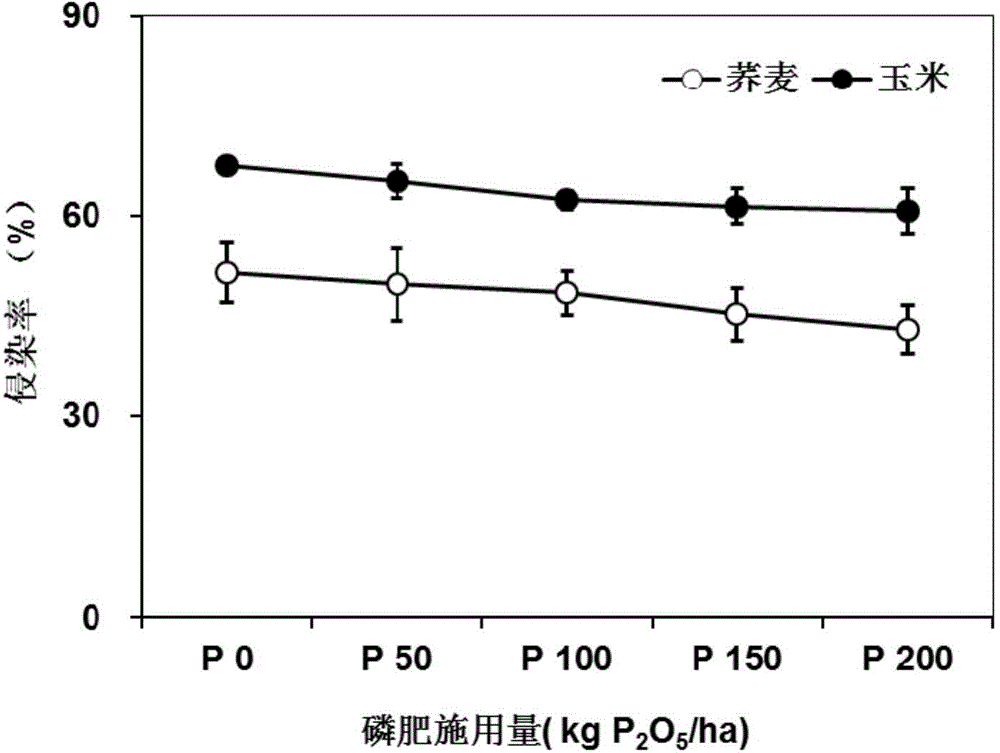Method for lowering cadmium content in soybeans by arbuscular mycorrhizal fungi
A technology for mycorrhizal fungi and soybeans, applied in the field of biological agriculture, can solve problems such as phytotoxicity, rice growth stagnation, and cell division obstacles, and achieve the effects of ensuring quality and safety and low operating costs.
- Summary
- Abstract
- Description
- Claims
- Application Information
AI Technical Summary
Problems solved by technology
Method used
Image
Examples
Embodiment 1
[0031] The field test site A soil with light to medium texture and good drainage suitable for soybean growth was selected to set up a split-plot test of mycorrhizal infection. The previous mycorrhizal crop corn and the non-mycorrhizal crop buckwheat were used as the main area respectively, and the amount of phosphorus applied was 0, 50, 100, 150 and 200 kg P 2 o 5 / ha was used as a test split plot, repeated four times, and this experimental design was used to control the infection rate of arbuscular mycorrhizal fungi on soybean roots.
[0032] After the above-mentioned treatment in the experimental field, soybeans were planted in plots and routine field management was carried out during the soybean growth period; soybean roots were collected 7-8 weeks after soybean sowing, and stained with trypan blue (Typan Blue) and amplified cross method. Calculate the infection rate of arbuscular mycorrhizal fungi. During the soybean harvest period, the soybean grains were washed, dried,...
Embodiment 2
[0035] A split-plot test of mycorrhizal infection was set up in field test site B soil with light-medium texture and good drainage suitable for soybean growth. The previous mycorrhizal crop corn and the non-mycorrhizal crop buckwheat were used as the main area respectively, and the amount of phosphorus applied was 0, 50, 100, 150 and 200 kg P 2 o 5 / ha was used as a test split plot, repeated four times, and this experimental design was used to control the infection rate of arbuscular mycorrhizal fungi to soybean.
[0036] After the above-mentioned treatment in the experimental field, soybeans were planted in plots and routine field management was carried out during the soybean growth period; soybean roots were collected 7-8 weeks after soybean sowing, and the soybean roots were collected by the trypan blue staining method (Typan Blue) and the enlarged cross method. Calculate the infection rate of arbuscular mycorrhizal fungi. During the soybean harvest period, the soybean grai...
PUM
 Login to View More
Login to View More Abstract
Description
Claims
Application Information
 Login to View More
Login to View More - R&D
- Intellectual Property
- Life Sciences
- Materials
- Tech Scout
- Unparalleled Data Quality
- Higher Quality Content
- 60% Fewer Hallucinations
Browse by: Latest US Patents, China's latest patents, Technical Efficacy Thesaurus, Application Domain, Technology Topic, Popular Technical Reports.
© 2025 PatSnap. All rights reserved.Legal|Privacy policy|Modern Slavery Act Transparency Statement|Sitemap|About US| Contact US: help@patsnap.com



